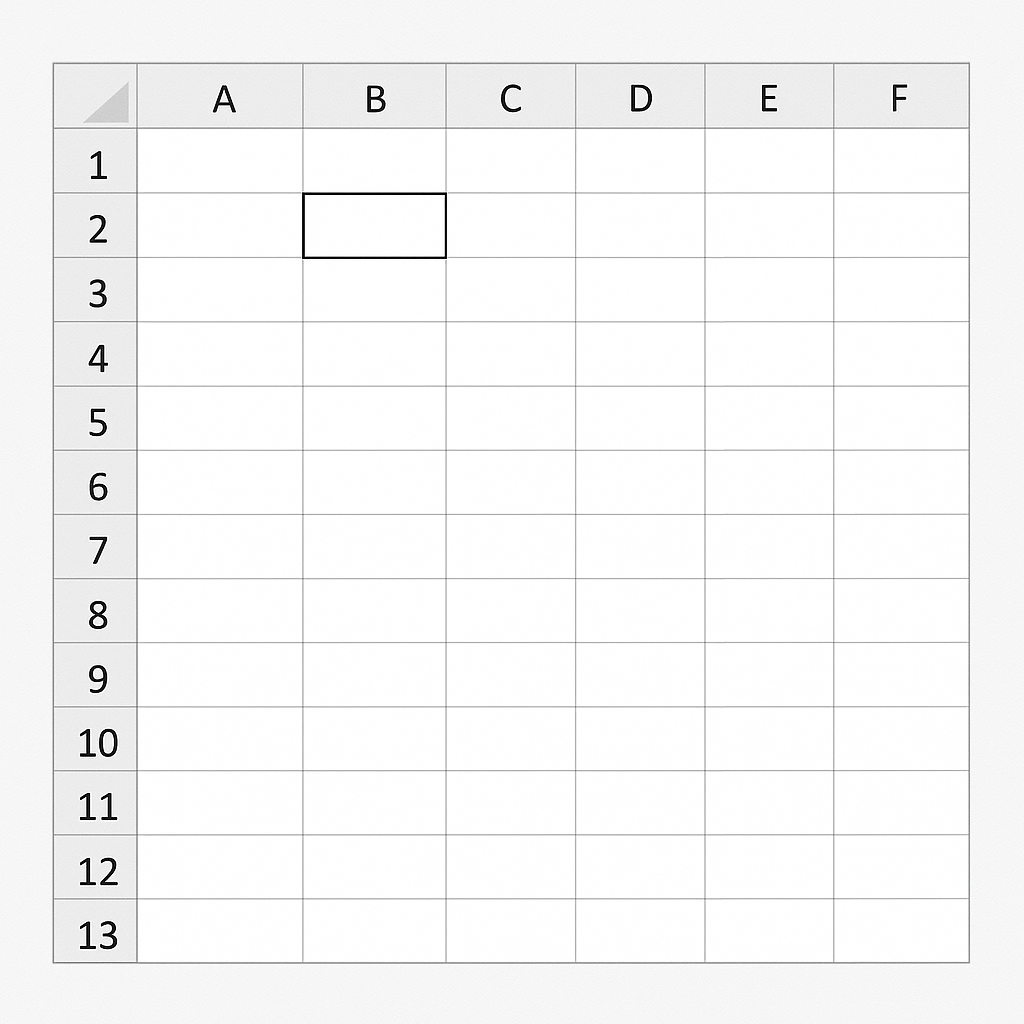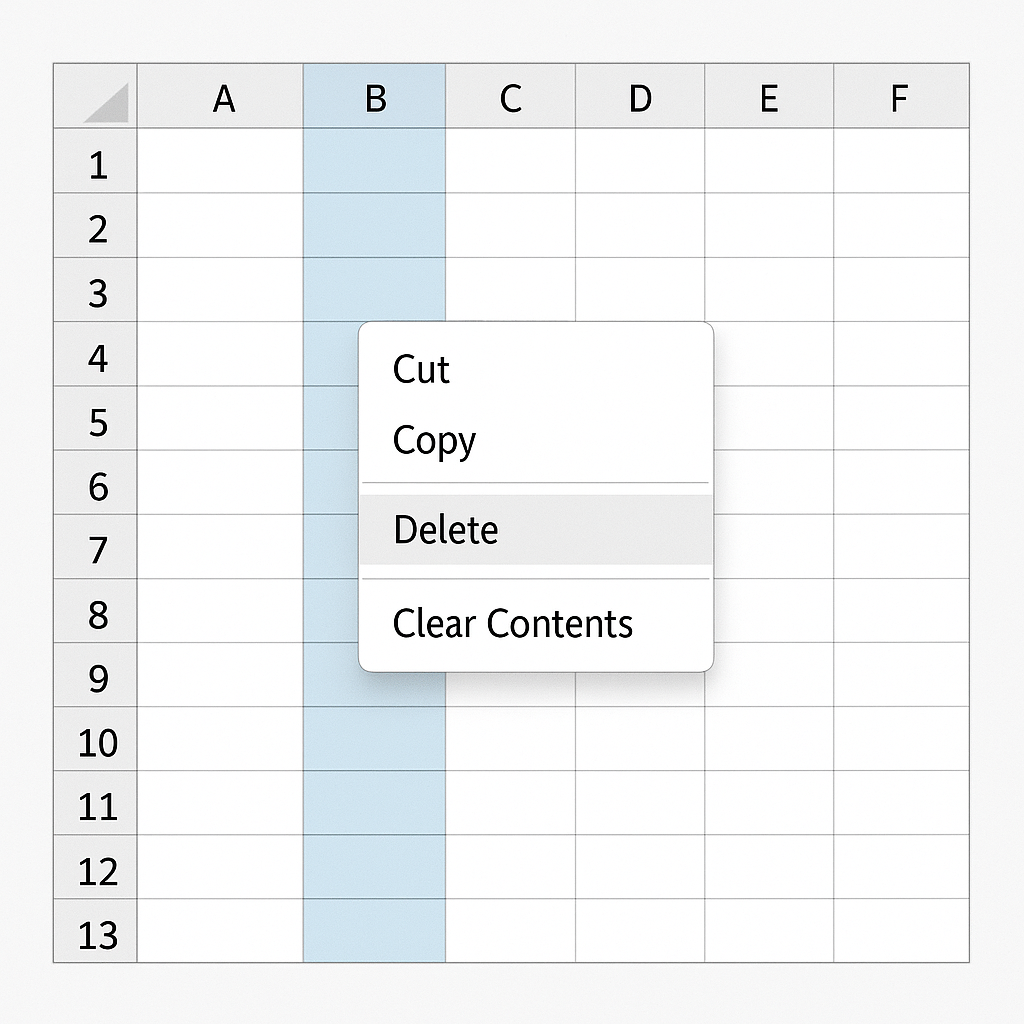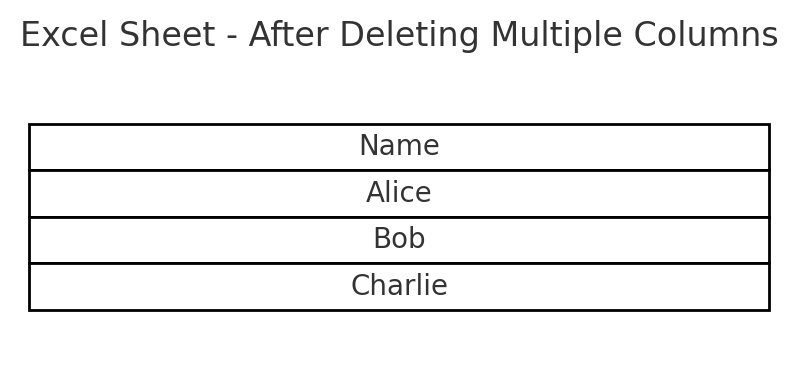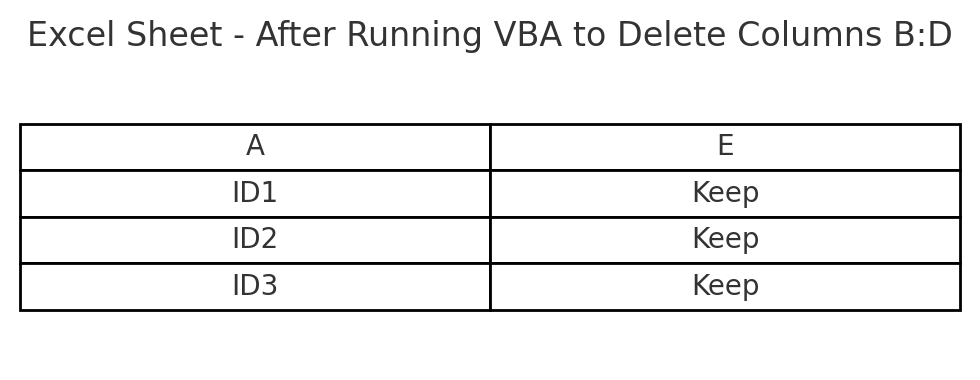
Deleting columns in Excel is a basic but important task. It helps you manage and clean your data effectively. Removing columns the right way can save time and avoid mistakes. This skill is useful for making reports, cleaning up extra fields, and optimizing spreadsheets for better performance. In this tutorial, you’ll learn how to delete one or more columns in Excel. We’ll share different methods, examples, and the perks of doing it right.
What Are Columns in Excel?
In Excel, a column is a vertical arrangement of cells identified by letters (A, B, C…Z, AA, AB, etc.). Columns are an essential part of how Excel organizes data. Each column typically represents a distinct data type such as:
- Names
- Dates
- Sales figures
- Email addresses
- Product IDs
Each cell in a column shares the same data structure vertically but can vary in content.

Example:
| A | B | C |
| Name | Sales | |
| John Doe | john@email.com | 1200 |
| Jane Smith | jane@email.com | 1500 |
In this example, columns A, B, and C each hold a different type of information.
How to Delete a Column in Excel
You can delete columns in Excel in a few ways. You might want to remove one column, several columns, or even blank ones.
Method 1: Right-Click to Delete a Column
This is the simplest and most common method for deleting a column.
Steps:
- Click the letter at the top of the column you want to delete (e.g., B).
- Right-click the selected column.
- Choose Delete.
The column will be removed and all data in that column will be deleted.

Method 2: Use the Ribbon Toolbar
Another easy method using the Excel interface.
Steps:
- Select the column(s) by clicking their headers.
- Go to the Home tab.
- In the Cells group, click Delete.
- Choose Delete Sheet Columns.
Useful when managing multiple columns and needing full control.

Method 3: Delete Multiple Columns at Once
To delete several columns:
Steps:
- Hold Ctrl (Windows) or Cmd (Mac) and click the letters of each column you want to delete.
- Right-click any selected column and click Delete.
You can also drag to select multiple adjacent columns and delete them in one go.

Method 4: Delete Blank Columns Using Go To Special
Ideal for cleaning large datasets.
Steps:
- Select your entire worksheet by pressing Ctrl + A.
- Go to Home > Find & Select > Go To Special.
- Select Blanks, then click OK.
- Right-click one of the highlighted columns and choose Delete → Entire Column.
Use caution with this method to avoid deleting important data accidentally.

Method 5: Use VBA to Delete Specific Columns (Advanced)
If you frequently clean data, VBA can help automate the task.
Sample Code:
Sub DeleteColumnB() Columns(“B”).Delete End Sub
To delete multiple columns:
Sub DeleteMultipleColumns() Columns(“B:D”).Delete End Sub
Access the VBA editor using Alt + F11, paste this code in a module, and run it.

Examples of Deleting Columns in Excel
Example 1: Removing Unused Columns in a Report
| Before | After |
| Name | |
| John | … |
Columns like “Phone” or “Age” may be irrelevant and easily removed for a cleaner report.

Example 2: Deleting Columns with Zero Sales
| Product | Q1 | Q2 | Q3 | Q4 | After |
| Widget | 10 | 0 | 0 | 15 | Q1, Q4 |
Blank or zero-filled sales columns can be deleted to focus on meaningful data.

Example 3: Cleaning Imported CSV Data
Often, when you import CSV or raw data, it contains dozens of empty columns. You can quickly select and remove all irrelevant columns to streamline your sheet.
Benefits of Deleting Unused or Unnecessary Columns in Excel
Deleting columns seems easy, but it offers big benefits. It improves data clarity, boosts performance, and enhances collaboration.
Improved Readability
Removing unnecessary columns declutters your spreadsheet, making it easier to read and navigate. Especially useful when presenting data to stakeholders, clients, or team members.
Enhanced File Performance
Large spreadsheets can slow down if they contain too much irrelevant or empty data. Deleting unnecessary columns:
- Reduces file size
- Speeds up recalculations
- Improves load time
This is critical when working with thousands of rows or multiple sheets.
Better Data Quality
Outdated or irrelevant columns can cause confusion or errors in calculations. Removing them reduces the risk of:
- Referencing wrong columns in formulas
- Misinterpreting data during analysis
- Copy-pasting incorrect fields
Cleaner Data Exports and Imports
Clean spreadsheets export better when sharing data between platforms like Excel, Power BI, Google Sheets, or SQL. Removing unnecessary columns prevents:
- Data mapping issues
- Sync errors
- Validation failures
Easier Collaboration
Simplified spreadsheets make it easier for collaborators to understand the data. Sharing files with your team is easier when you include only the necessary columns. This helps speed up decision-making and cuts down on confusion.
Streamlined Printing and Reporting
Fewer columns mean cleaner printed reports. You can fit data on one page, improve layout, and present more professionally.
How To (Quickly) Delete (Or Remove) A Column, Or Multiple Columns In Excel Explained
FAQs – Deleting Columns in Excel
Can I undo a deleted column?
Yes. Press Ctrl + Z immediately after deletion to undo the action. However, once saved and closed, deleted data cannot be recovered unless backed up.
What happens to formulas if I delete a column?
If a formula refers to a deleted column, Excel may return a #REF! error. Always double-check formulas after deleting any columns.
How do I delete columns in a protected sheet?
You must first unprotect the sheet:
- Go to Review > Unprotect Sheet.
- Enter the password (if set).
- Delete columns as needed.
Can I delete columns in Excel Online?
Yes. Right-click the column header. Then, select “Delete column,” just like in the desktop version.
Is there a shortcut to delete a column?
Yes. Select the column, then press:
Ctrl + – (Windows) Cmd + – (Mac)
Choose Entire column when prompted.
Conclusion
Deleting columns in Excel is a key skill. It helps keep your spreadsheets clean and easy to use. Removing extra columns lets you focus on what matters. This is true whether you have a small dataset or a big report. This guide offers all you need to delete columns in Excel. It covers everything from simple right-click methods to advanced VBA scripts. This simple step also helps improve data quality, performance, and teamwork.
